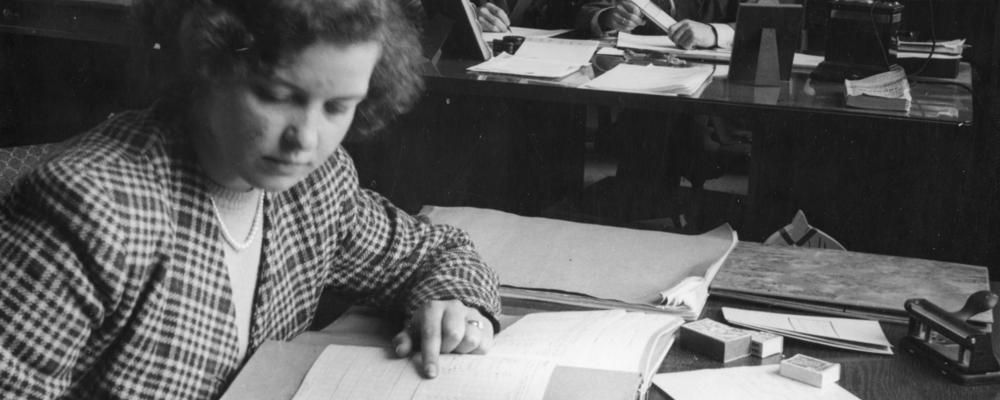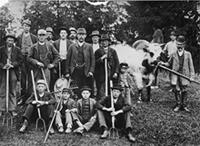Albrecht, James, Anders Björklund & Susan Vroman. Unionization and the evolution of the wage distribution in Sweden: 1968–2000. Industrial and Labor Relations Review 64 (2011): 1039–1057.
Allen, G. R. A comparison of real wages in Swedish agriculture and secondary and tertiary industries, 1870–1949. Scandinavian Economic History Review 3 (1955): 85–107.
Bagge, Gösta, Erik Lundberg & Ingvar Svennilson. Wages in Sweden 1860–1930. I & II. London: P.S. King & Son, 1933/1935.
Bengtsson, Tommy Migration, wages, and urbanization in Sweden in the nineteenth century. I A. van der Woude, A. Hayami & J. de Vries (red.), Urbanization in history: A process dynamic interaction. Oxford: Clarendon Press, 1990: 186–204.
Bengtsson, Tommy & Lennart Jörberg. Regional wages in Sweden during the 19th century. I P. Bairoch & M. Lévy-Leboyer (red.). Disparities in economic development since the industrial revolution. Basingstoke: Macmillan, 1981.
Björklund, Jörgen & Hans Stenlund. Real wages in Sweden, 1870–1950: a study of six industrial branches. I P. Scholliers & V. Zamagni (red.), Labour's reward. Hants, UK: Elgar, 1995: 151–66.
Bohlin, Jan & Anna-Maria Eurenius. Why they moved: emigration from the Swedish countryside to the United States, 1881–1910. Explorations in Economic History 47 (2010): 533–551.
Burnette, Joyce & Maria Stanfors. Estimating historical wage profiles. Historical Methods 48 (2015): 35–51.
Burnette, Joyce & Maria Stanfors. Was there a family gap in late nineteenth century manufacturing? Evidence from Sweden. History of the Family 17 (2012): 31–50.
Calmfors, Lars & Anders Forslund. Real-Wage determination and labour market policies: The Swedish experience. Economic Journal 101 (1991): 1130–48.
Edin, Per Anders & Bertil Holmlund. The Swedish wage structure: The rise and fall of solidarity wage policy. I R. B. Freeman and L. Katz (red.), Differences and Changes in Wage Structures. Chicago: University of Chicago Press, 1995.
Edin, Per Anders & Johnny Zetterberg. Interindustry wage differentials: Evidence from Sweden and a comparison with the United States. American Economic Review 82 (1992): 1341–49.
Enflo, Kerstin, Christer Lundh & Svante Prado. The role of migration in regional wage convergence: Evidence from Sweden 1860–1940. Explorations in Economic History 52 (2014): 93–110.
Fregert, Klas. The Great Depression in Sweden as a wage coordination failure. European Review of Economic History 4 (2000): 341–360.
Friberg, Kent. Intersectoral wage linkages: The case of Sweden. Empirical Economics 32 (2007): 161–84.
Gärtner, Svenja. New macroeconomic evidence on internal migration in Sweden, 1967–2003. Regional Studies online 2014.
Gärtner, Svenja. German stagnation versus Swedish progression: Gender wage gaps in comparison, 1960–2006. Scandinavian Economic History Review 62 (2014): 137–162.
Hansen, Jörgen. The Effect of Work Absence on Wages and Wage Gaps in Sweden. Journal of Population Economics 13 (2000): 45–55.
Hibbs Donald A. Wage compression under solidarity wage bargaining in Sweden. FIEF Economic Research Report No. 30. Stockholm: Trade Union Institute for Economic Research. Stockholm: FIEF, 1990
Hibbs, Donald A & Håkan Locking. Wage compression, wage drift and wage inflation in Sweden. Labour Economics 3 (1996): 104–41.
Hibbs Jr, Donald A & Håkan Locking. Wage dispersion and productive efficiency: Evidence for Sweden. Journal of Labor Economics 18 (2000): 755–782.
Holmlund, Bertil & Henry Ohlsson. Wage linkages between private and public sectors in Sweden. Labour 6 (1992): 3–17.
Jansson, Anders, Lennart Andersson Palm & Johan Söderberg. Dagligt bröd i onda tider: priser och löner i Stockholm och Västsverige 1500–1700. Göteborg. Götene: Institutet för Lokalhistorisk Forskning, 1991.
Jungenfelt, Karl G. Löneandelen och den ekonomiska utvecklingen. En empirisk-teoretisk studie. Uppsala: Almqvist & Wicksell, 1966.
Jörberg, Lennart. A History of Prices in Sweden 1732–1914: Volume I Sources, Methods and Tables. Lund: Gleerup, 1972.
Kommunalarbetarnas löner i Sverige 1865–1930. Undersökning, verkställd på uppdrag av Svenska städernas förhandlingsorganisation. Stockholm 1933.
Larsson, M. (1986). Arbete och lön vid Bredsjö bruk: en studie av löneprinciper och lönenivåer för olika yrkeskategorier vid Bredsjö bruk 1828–1905. Uppsala: Uppsala studies in Economic History, no 26.
Le Grand, Carl & Ryszard Szulkin. Permanent disadvantage or gradual integration: explaining the immigrant–native earnings gap in Sweden. Labour 16 (2002): 37–64.
Ljungberg, Jonas. Earnings differentials and productivity in Sweden, 1870-1980. I S. Heikkinen and J. L. van Zanden (red.), Exploring economic growth. Amsterdam: International Institute of Social History, 2004.
Ljungberg, Jonas. The impact of the great migration on the Swedish economy. Scandinavian Economic History Review 45 (1997): 159–89.
Lundh, Christer. Spelets regler: institutioner och lönebildning på den svenska arbetsmarknaden 1850–2000. Stockholm: SNS, 2010.
Lundh, Christer. Statarnas löner och levnadsstandard. I C. Lundh & M. Olsson (red.). Statarna i myt och verklighet. Stockholm: Gidlunds, 2007.
Lundh, Christer. Wage formation and institutional change in the Swedish labour market 1850-2000. I C. Lundh, J. Olofsson, L. Schön & L. Svensson (red.), Wage formation, labour market institutions and economic transformation in Sweden 1860–2000. Almqvist & Wiksell, 2004: 92–142.
Lundh, Christer. Wage forms, costs of living and the urban–rural wage gap: Southern Sweden, 1881–1930. Scandinavian Economic History Review 60 (2012): 123–145.
Lundh, Christer. Was there an urban–rural consumption gap? The standard of living of workers in southern Sweden, 1914–1920. Scandinavian Economic History Review 61 (2013): 233–258.
Lundh, Christer & Svante Prado. Markets and politics: The Swedish urban–rural wage gap, 1865–1985. European Review of Economic History 19 (2015): 67–87.
Lundh, Christer, Lennart Schön & Lars Svensson. Real Wages in Sweden 1860–1914. I C. Lundh, J. Olofsson, L. Schön & L.- Svensson. Wage formation, labour market institutions and economic transformation in Sweden 1860–2000. Lund: Dept. of Economic History, Lund University, 2004.
Lundh, Christer, Lennart Schön & Lars Svensson. Regional wages in industry and labour market integration in Sweden, 1861–1913. Scandinavian Economic History Review 53 (2005): 71–84.'
Lundh Nilsson, Fay. Lönande lärande. Teknologisk förändring, yrkesskicklighet och lön i svensk verkstadsindustri omkring 1900. Lund: Ekonomisk historiska institutionen, Lunds Universitet, 2007.
Meyerson, Eva & Trond Petersen. Lika lön för lika arbete. I I. Persson & E. Wadensjö (red.), Kvinnors och mäns löner – varför så olika? SOU 1997:136.
Nyström, Bertil. Löner och levnadskostnader vid statens järnvägsbyggnader och statens vattenfallsverks byggnadsföretag samt inom därmed jämförliga arbetsområden. Stockholm: K. Socialstyrelsen, 1924.
Nyström, Bertil. Lantarbetarlönernas variationer och orsakerna därtill. Kungl. Landtbruks-akademiens handlingar och tidskrift 77 (1938): 263–75.
Prado, Svante. Fallacious convergence? Williamson's real wage comparisons under scrutiny. Cliometrica 4 (2010): 171–205.
Prado, Svante, Nominal and real wages of manufacturing workers, 1860–2007. I R. Edvinsson, T. Jacobson & D. Waldenström (red.), Exchange rates, prices, and wages, 1277–2008. Del. 1. Stockholm: Ekerlids förlag, 2010: 479–527.
Schön, Lennart. The wage share, cycles and the Kuznets curve of income distribution. I C. Lundh, J. Olofsson, L. Schön & L. Svensson (red.), Wage formation, labour market institutions amd economic transformation in Sweden 1860–2000. Lund: Almqvist & Wicksell International, 2004: 19–44.
Stanfors, Maria et al. Gender, productivity and the nature of work and pay: Evidence from the late nineteenth-century tobacco industry. Economic History Review 67 (2014): 48–65.
Stanfors, Maria. Könslöneskillnader före den moderna arbetsmarknadens genombrott. Ekonomisk Debatt 41 (2013): 5–13.
Stanfors, Maria. Mellan arbete och familj. Ett dilemma för kvinnor i 1900-talets Sverige. Stockholm: SNS förlag, 2007.
Stanfors, Maria, Tim Leunig, Björn Eriksson & Tobias Karlsson. Gender, productivity, and the nature of work and pay: evidence from the late nineteenth-century tobacco industry. Economic History Review 67 (2014): 48–65.
Svensson, Lars. Closing the gender gap: Determinants of change in the female-to-male blue collar wage ratio in Swedish manufacturing 1913–1990. Lund: Dept. of Economic History, Lund University, 1995.
Svensson, Lars. Explaining equalization: Political institutions, market forces, and reduction of the gender wage gap in Sweden, 1920–95. Social Science History 27 (2003): 371–95.
Svensson, Lars. Industrial dynamics, labour demand, and wage differentials in the Swedish manufacturing industry 1930–1990. I C. Lundh, J. Olofsson, L. Schön & L. Svensson (red.), Wage formation, labour market institutions amd economic transformation in Sweden 1860–2000. Almqvist & Wiksell, 2004: 161–80.
Svensson, Lars. A story of equalisation: female and male wages in Sweden 1920–1995. I C. Lundh, J. Olofsson, L. Schön & L. Svensson (red.), Wage formation, labour market institutions amd economic transformation in Sweden 1860–2000. Almqvist & Wiksell, 2004: 204–28.
Söderberg, Johan. Long-term trends in real wages of labourers. I R. Edvinsson, T. Jacobsson & D. Waldenström (red.), Exchange Rates, Prices, and Wages, 1277–2008. Vol. 1. Stockholm: Ekerlids förlag, 2010: 453–478.
Söderberg, Johan. Real wage trends in urban Europe, 1730–1850: Stockholm in a comparative perspective. Social History (1987) 12: 155–176.
Söderberg, Johan. Regional economic disparity and dynamics 1840–1914. The Journal of European Economic History 14 (1985): 273–296.
Söderberg, Johan. Wage differentials in Sweden, 1725-1950. I. Y. S. Brenner, H. Kaelble & M. Thomas (red.), Income distribution in historical perspective. Cambridge: Cambridge University Press, 1991: 76–95.
Söderberg, Johan, Ulf Jonsson & Christer Persson. A stagnating metropolis: the economy and demography of Stockholm 1750–1850. Cambridge: Cambridge University Press, 1991.
Söderberg, Johan. Hade Heckscher rätt? Priser och reallöner i 1500-talets Stockholm. Historisk tidskrift 107 (1987): 351–356


